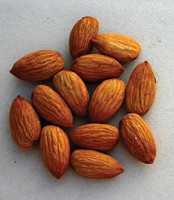Impact Of Dry Stressing Almonds During Water Shortages

During the growing season of 2008, many almond orchards were stressed for water. Some may have been stressed unintentionally, while others may have been so for lack of choice due to the limited availability of water. It was not uncommon in 2008 to see Nonpareil kernel sizes in the mid-30s where trees were severely stressed during the May/June/July period due to rationing of water.
Adjacent fields with access to alternative irrigation sources or those fortunate to have good-quality wells saw kernel sizes in the mid-20s by comparison. A change from say a size 24 to a size 34 could represent a magnitude of crop reduction in the 30% to 40% range due to small and shriveled kernels.
The reduction in crop weight is the obvious aspect of this stressing, but there are other factors that are affected by the crop quality. The color, texture, and flavor of these flattened and desiccated kernels are also adversely affected. To me, they almost have a rancid taste and have the consistency of cardboard. They also tend to be dark in color and heavily ridged due to the dehydration. This certainly cannot have a positive impact with potential buyers. Also, for those who market nuts based on kernel sizes, substantial price differences can be seen with the tiny kernels.
A Challenging Harvest
Hulltights and sticktights which are associated with severe preharvest water stress negatively impact harvest. The cost of shaking goes up, more poling is required, and sometimes more trunk damage occurs due to more vigorous shaking. Greater defoliation at harvest also hampers sweeping and pickup due to the vast volume of leaves to deal with.
Hulling and shelling of the hulltights is more difficult and can increase chips and scratches and foreign material, thus lowering the grower’s grade. The sticktights remaining on the trees will exacerbate navel orangeworn potential the following year.
Postharvest refoliation and/or spent flower buds will debilitate bloom strength the following season. Varieties like Price or Sonora may even have bloom failure next spring.
Another obvious impact of preharvest water stress is the late-season expression of salt burn on the foliage. In orchards with marginal water quality, the combination of dry stressing trees and applications of insufficient water to leach salts has resulted in many orchards showing severe leaf burn at and shortly after harvest. Often this may not show up in the earlier July leaf analysis, but leaf levels analyzed in September show highly toxic levels of salts.
As indicated above, the impacts of severely shorting almond trees for water during the growing season are multifaceted and interrelated. These criteria would create a strong argument in favor of making all attempts to ensure almond growers receive the necessary water to produce their crops due to the sensitive nature of this perennial crop.










